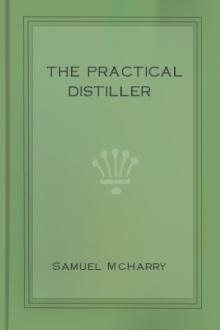The Practical Distiller by Samuel McHarry (best book recommendations TXT) 📕

- Author: Samuel McHarry
- Performer: -
Book online «The Practical Distiller by Samuel McHarry (best book recommendations TXT) 📕». Author Samuel McHarry
Considerations such as those have combined to determine a publication of my work; fully apprised of the scoffs of pedants, kicks, bites and bruises of critics--but I hope they will find latitude for the exercise of a share of compassion, when I inform them candidly, that a mill and distillery, or still house, were substituted for, and the only college and academy in which I ever studied, and those studies were broken, and during the exercise of my business, as a miller and distiller.
That it contains errors in the diction and perspicuity, I will readily confess--but that it is in substance true, and contains much useful information, I must declare as an indisputable fact. And though the road I travelled was a new one, without compass, chart, or even star to steer by, not even a book to assist me in thinking, or cheer me in my gloomy passage--seeking from those springs of nature, and inherent endowments for consolatory aid--pressing on a frequent





Comments (0)